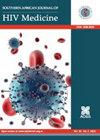Birth outcomes following antiretroviral exposure during pregnancy: Initial results from a pregnancy exposure registry in South Africa
IF 1.6
4区 医学
Q4 INFECTIOUS DISEASES
引用次数: 20
Abstract
Background In 2013, a pregnancy exposure registry and birth defects surveillance (PER/BDS) system was initiated in eThekwini District, KwaZulu-Natal (KZN), to assess the impact of antiretroviral treatment (ART) on birth outcomes. Objectives At the end of the first year, we assessed the risk of major congenital malformations (CM) and other adverse birth outcomes (ABOs) detected at birth, in children born to women exposed to ART during pregnancy. Method Data were collected from women who delivered at Prince Mshiyeni Memorial Hospital, Durban, from 07 October 2013 to 06 October 2014, using medicine exposure histories and birth outcomes from maternal interviews, clinical records and neonatal surface examination. Singleton births exposed to only one ART regimen were included in bivariable analysis for CM risk and multivariate risk analysis for ABO risk. Results Data were collected from 10 417 women with 10 517 birth outcomes (4013 [38.5%] HIV-infected). Congenital malformations rates in births exposed to Efavirenz during the first trimester (T1) (RR 0.87 [95% CI 0.12–6.4; p = 0.895]) were similar to births not exposed to ART during T1. However, T1 exposure to Nevirapine was associated with the increased risk of CM (RR 9.28 [95% CI 2.3–37.9; p = 0.002]) when compared to the same group. Other ABOs were more frequent in the combination of HIV/ART-exposed births compared to HIV-unexposed births (29.9% vs. 26.0%, adjusted RR 1.23 [1.14–1.31; p < 0.001]). Conclusion No association between T1 use of EFV-based ART regimens and CM was observed. Associations between T1 NVP-based ART regimen and CM need further investigation. HIV- and ART-exposed infants had more ABOs compared to HIV-unexposed infants.妊娠期抗逆转录病毒暴露后的出生结果:南非妊娠暴露登记的初步结果
背景2013年,夸祖鲁-纳塔尔省eThekwini区启动了妊娠暴露登记和出生缺陷监测(PER/BDS)系统,以评估抗逆转录病毒治疗(ART)对出生结果的影响。目的在第一年年底,我们评估了妊娠期接受抗逆转录病毒治疗的妇女所生的孩子在出生时发现的严重先天畸形(CM)和其他不良出生结局(ABO)的风险。方法收集2013年10月7日至2014年10月6日在德班Mshiyeni王子纪念医院分娩的妇女的数据,使用药物暴露史和产妇访谈、临床记录和新生儿表面检查的出生结果。仅接受一种ART方案的单胎出生被纳入CM风险的双变量分析和ABO风险的多变量风险分析。结果收集了10 417名妇女的数据,其中10 517名为出生结局(4013名[38.5%]HIV感染者)。妊娠早期(T1)暴露于依非韦仑的新生儿的先天畸形率(RR 0.87[95%CI 0.12–6.4;p=0.895])与T1期间未暴露于ART的新生儿相似。然而,与同一组相比,T1暴露于奈韦拉平与CM风险增加有关(RR 9.28[95%CI 2.3-37.9;p=0.002])。与未暴露于HIV的新生儿相比,其他ABO在暴露于HIV/ART的新生儿中更常见(29.9%对26.0%,调整后的RR 1.23[1.14-1.31;p<0.001])。结论未观察到T1使用基于EFV的ART方案与CM之间的相关性。基于T1 NVP的ART方案与CM之间的相关性需要进一步研究。与未接触艾滋病病毒的婴儿相比,接触艾滋病病毒和抗逆转录病毒疗法的婴儿有更多的ABO。
本文章由计算机程序翻译,如有差异,请以英文原文为准。
求助全文
约1分钟内获得全文
求助全文
来源期刊
CiteScore
2.80
自引率
11.80%
发文量
41
审稿时长
>12 weeks
期刊介绍:
The Southern African Journal of HIV Medicine is focused on HIV/AIDS treatment, prevention and related topics relevant to clinical and public health practice. The purpose of the journal is to disseminate original research results and to support high-level learning related to HIV Medicine. It publishes original research articles, editorials, case reports/case series, reviews of state-of-the-art clinical practice, and correspondence.

 求助内容:
求助内容: 应助结果提醒方式:
应助结果提醒方式:


